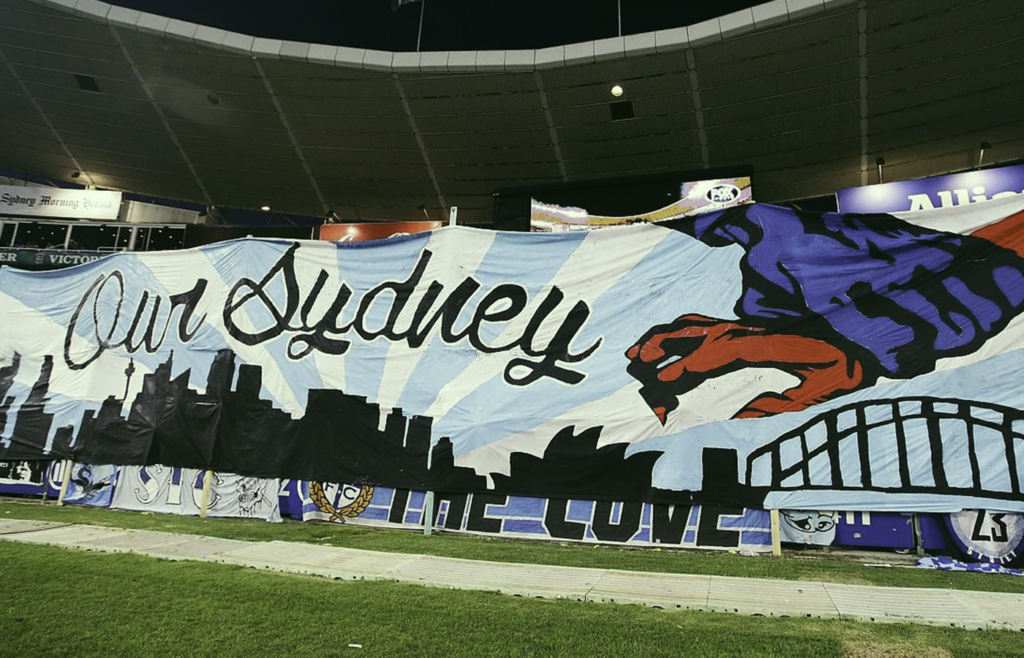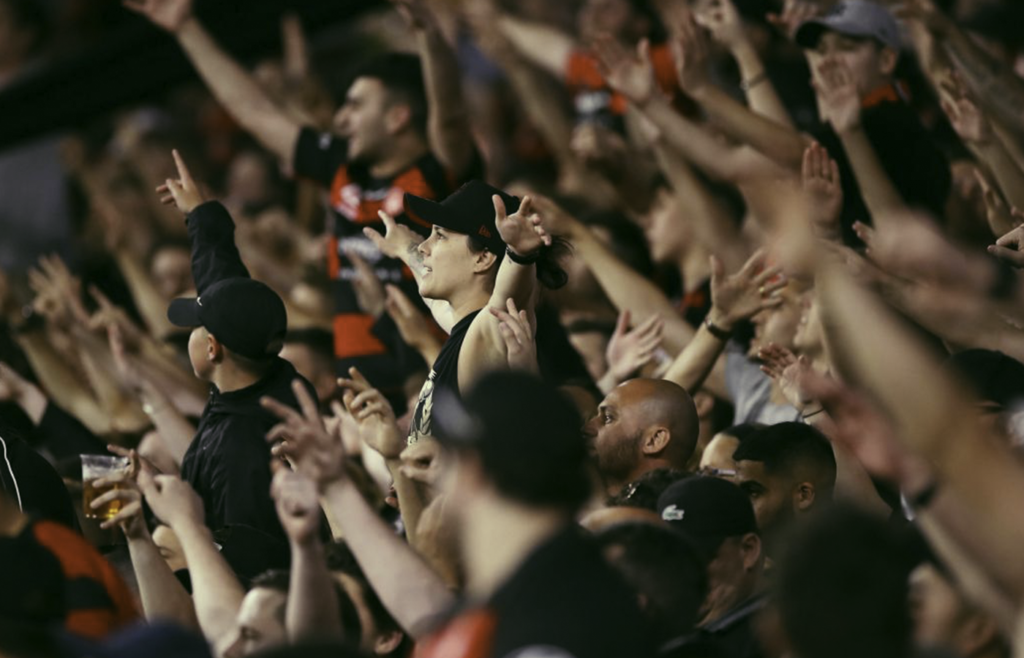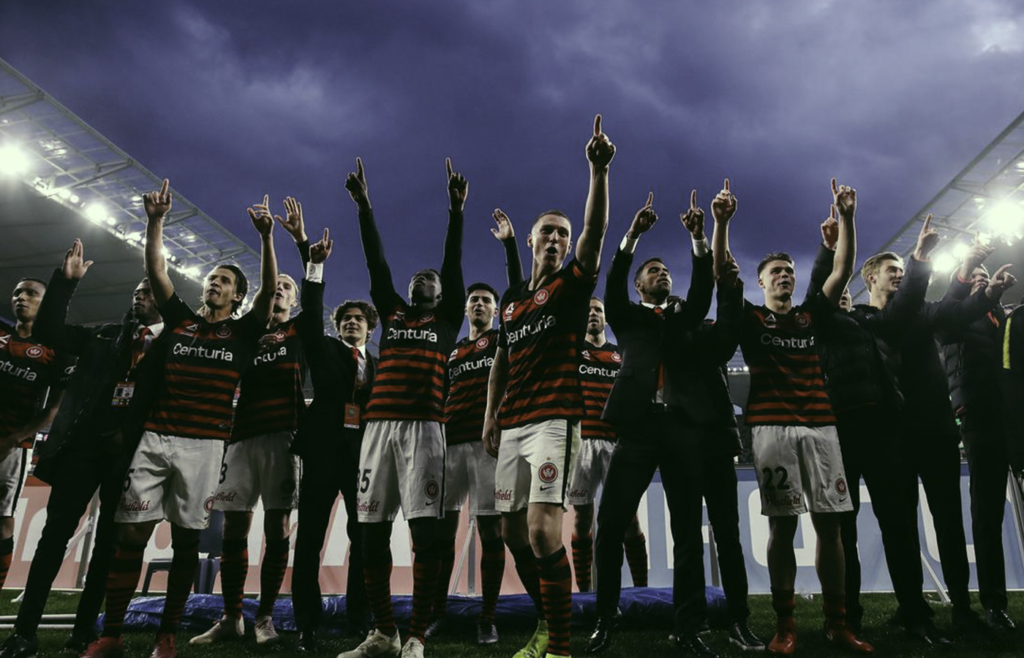Joe Gorman is a journalist and author. His first book, The Death and Life of Australian Soccer, was hailed as ‘one of the best and most important written on Australian sport’ by The Age, and long-listed for the 2017 Walkley Book Award. With the PFA, Joe will explore various issues impacting Australian football.

Words by Joe Gorman
Alex Wilkinson had watched from afar as the Sydney derby grew. When he was playing in Korea, between 2012 and 2015, the former Socceroos defender saw the rivalry develop from concept to thriving reality. By the time he returned to Melbourne City, in 2016, the Sydney derby was already the hottest ticket in the A-League. Yet it still came as a surprise, when Wilkinson made his first appearance for Sydney FC in Round 1 of the 2016-17 season, to be greeted by the wall of noise generated by more than 60,000 fans at Stadium Australia – half in sky blue, the other half in red and black.
It felt, at that moment, like the Sydney derby had truly arrived. Despite only a few seasons of history, here was the largest crowd for a regular season football fixture, creating an intense rivalry that so effortlessly distilled the “west against the rest” divide of Australia’s biggest city.
“That’s what captured it so well: the geographic locations of both teams and both fan bases added to the rivalry,” Wilkinson recalls. “As a player, it was an unbelievable experience to play in front of that many people. It’s pretty rare – although I’ve been lucky enough to play overseas and play for the national team – to play in front of crowds that big. To be able to do it in my hometown, for my home club, was really exciting.”
In some ways, that Round 1 derby was a prelude of things to come. Sydney FC won 4–0 thanks to an avalanche of second half goals, and have since won three A-League premierships and three grand finals. Four and a half years after making his debut for the club, Wilkinson has become the backbone for one of the greatest club sides Australia has ever seen.
Yet there is no doubt that the Sydney derby has dwindled in the seasons that followed. The passion, protest and pantomime that once made the fixture between Sydney FC and Western Sydney Wanderers unmissable has been diminished by a number of factors, many of them beyond the A-League’s control.

First, there was the redevelopments of Parramatta Stadium and the Sydney Football Stadium, which forced both clubs away from their home grounds. Attendances at Wanderers games – including the derbies – immediately dropped. Then there was the civil war that played out between A-League clubs and the governing body, Football Australia, which had a deleterious effect on the game’s confidence and momentum. And there was also the global pandemic which interrupted football and kept fans away from stadiums.
There is nothing that Wilkinson or any other player can do to arrest the decline of the Sydney derby. Indeed, what made the fixture so special was that it was dependent not on the players but on the enthusiasm of the supporters. According to sports academic Hunter Fujak, the active fan groups – The Cove for Sydney FC, The Red and Black Bloc for the Wanderers – are the lifeblood of the fixture.
“It is fair to say that the most unique selling proposition of soccer in this country is active fan groups,” says Fujak, the author of Code Wars: The Battle for Fans, Dollars and Survival. “No other code does anything like it. The atmosphere created by 15,000 people at a soccer match far exceeds that produced by 30,000 people at an AFL game.
“At the peak of the Sydney derby, when it was selling out, it was really the atmosphere of the active fan groups that created an incentive for the more casual fans to come. I don’t think casual fans flocked to the derby because of the product on the field; it was because they knew there’d be a lot of people and that was driven by the atmosphere of the active fan groups.”

Of course, that active support is now at its lowest ebb, which makes the A-League seem smaller and less relevant with every passing season. Yet there is still so much promise for the Sydney derby, which Fujak believes has more growth potential than any of the local rivalries in the NRL and more authenticity than the AFL derby between the Sydney Swans and the Greater Western Sydney Giants.
“Undoubtedly the rivalry is a lot stronger than the Sydney AFL derby, and if you look at how the NRL have to drum up interest in something being a ‘derby’, it’s entirely driven by marketing and media,” says Fujak.
“Whereas the Sydney derby in the A-League was very much an ‘on the street derby’. When the derby first came to prominence, it was organically driven. The media has never been super-friendly to the A-League or to soccer, but the buzz around that game was very much word-of-mouth, grassroots level growth. And it got so big that it cracked the mainstream, and media had to talk about it. But the initial groundswell was the buzz around the game and the fan groups tapping into deeper cultural perspectives of Sydney as a city.”

To understand that initial groundswell of support is to understand the story of professional football in Sydney, as well as the growth of the city.
According to the Greater Sydney Commission, over the next four decades Sydney is expected to grow into a “metropolis of three cities” encompassing the Western Parkland City, centred around the Macarthur region in the southwest; the Central River City, centred around Parramatta; and the Eastern Harbour City, centred around the CBD and the Harbour.
Football, after years of misdirection and wasted opportunities, may be the best placed sport to capitalise on this demographic trend. Gone are the small suburban teams that existed in the old National Soccer League between 1977 and 2004, none of which managed to capture the love or attention of the general public. Now, Sydney is represented by Sydney FC near the Harbour, Western Sydney Wanderers in Parramatta, and Macarthur FC in the southwest.

Despite the A-League’s current troubles, having a franchise in each major hub is undoubtedly the game’s best chance of success. “Overall, I think the positioning of the clubs in Sydney is really clever in terms of the long-term growth of the league,” says Fujak.
These three franchises are underpinned by a massive latent fanbase waiting to be engaged. Indeed, the participation statistics should provide the platform for Sydney’s century of soccer. According to Sport Australia’s AusPlay most recent survey of sport and physical activity participation, football is the sport of choice in the local government areas of Sydney. It is estimated that more than 300,000 people play football – roughly five times more participants than cricket or basketball, and around six times the number of rugby league participants. Australian Rules, which lovingly refers to itself as the national game, doesn’t even make the list of top ten activities.

Without great fanfare, football now reigns in in Sydney’s schoolyards and workplaces and weekends of organised sport. The challenge for the professional game, as it has been for the past four decades, is to continue to convert this enormous number of participants into supporters at the gate.
Reactivating the Sydney derby will be crucial in this process. This is the fixture which is proven to be a drawcard for diehards and new fans alike, the calendar event that can give football some positive momentum after several seasons of apathy and disinterest.
Tomorrow’s derby has all the right ingredients: it is a must-win game for eighth-placed Western Sydney, while Sydney FC are searching for their first win over the Wanderers in more than two years. More importantly, it will be the first game at Western Sydney Stadium in front of fans since the start of the coronavirus pandemic.
“In the stands, I think it has dropped away a little bit,” concedes Wilkinson. “But as players, its still one of the marquee fixtures which we look forward to the most, so from a player’s point of view it hasn’t diminished at all.”
Australian football has long been guilty of massive hubris and overblown expectations, and the future of the league is by no means secure. Yet football, for the first time in its history, now boasts three well-capitalised teams that are positioned to take advantage of the future growth of Sydney, and a derby that has the potential to shape the narrative of the city itself.
Read more articles from Joe Gorman:
📰 The Long Read by Joe Gorman: Australian football’s Indigenous engagement
📰 The Long Read by Joe Gorman: Wellington’s relocation
📰 The Long Read by Joe Gorman: Carroll Roar’s unsung hero
📰 The Long Read by Joe Gorman: Chasing records with Milos Degenek







